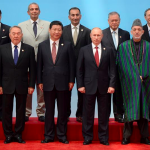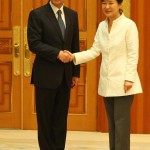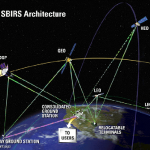- DETERRENCE: China Calls for New Asian Security Structure
- DPRK: China Agrees North Korea’s Nuclear Activities a Serious Threat, Says South
- GOVERNANCE AND CIVIL SOCIETY: Why are China’s Neighbors so Afraid of Her?
- CLIMATE CHANGE ADAPTATION: Identifying Vulnerable Populations in Subtropical Brisbane, Australia: A Guide for Heatwave Preparedness and Health Promotion
- ENERGY SECURITY: John Browne, Former Chief Executive at BP, becomes the Face of Fracking in Britain
- AUSTRAL PEACE AND SECURITY: Ballistic Missile Defence: How Soon, How Significant, and What should Australia’s Policy Be?
 DETERRENCE: China Calls for New Asian Security Structure, Louise Watt, Associated Press (20 May 2014)
DETERRENCE: China Calls for New Asian Security Structure, Louise Watt, Associated Press (20 May 2014)
Xi Jinping: “We need to innovate our security cooperation (and) establish a new regional security cooperation architecture,” at the Conference on Interaction and Confidence-building measures in Asia including a “security dialogue and cooperation platform,” “a defense consultation mechanism,” and a “security response center” for major emergencies.
- China and Russia Kick Off Joint Naval Drills, Sam LaGrone, USNI News, May 21, 2014
- Russia and China seal historic $400bn gas deal, RT News, May 21, 2014
- Navy Braces For Backlash After PLA Cyber Indictments, Sydney Freedberg, Breaking Defense, May 21, 2014
- China, Russia “concerned” over Korean peninsula nuclear issue, Xinhua, May 20, 2014
 DPRK: China Agrees North Korea’s Nuclear Activities a Serious Threat, Says South. Jack Kim, UK Reuters (26 May 2014)
DPRK: China Agrees North Korea’s Nuclear Activities a Serious Threat, Says South. Jack Kim, UK Reuters (26 May 2014)
China is increasingly favoring South Korea, South Korea’s economy and sometimes agreeing with South Korea’s narrative of relationships in Northeast Asia. Both South Korea and China are preparing for Chinese President Xi Jinping’s upcoming State Visit to South Korea. However, this is taking place against the backdrop of ships crossing the Northern Limit Line and exchanges of artillery fire in which no one is struck. Such exchanges are unhelpful, but also do not raise tensions in the way they would have done in the past. The U.S. and North Korea held Track 1.5 meetings very quietly in Mongolia where talks were not a reward, but something in U.S. interest. Something is changing although it is likely too early to say exactly what has changed and it is certainly too early to say what that change means.
- Korea, China strengthen partnership. Wi Tack-whan, Limb Jae-un, Korea.net (27May 2014)
- Wang Yi: China is willing to take the Republic of Korea as a more important cooperative partner in the future. China Ministry of Foreign Affairs. (26 May 2014)
- South Korean President Park Guen-hye meets with Wang Yi, Zhang Qing, (Shanghai, China) Liberty Daily. (27 May 2014) [Chinese language]
 GOVERNANCE AND CIVIL SOCIETY: Why are China’s Neighbors so Afraid of Her?, Yang Hengjun, The Diplomat (23 May 2014)
GOVERNANCE AND CIVIL SOCIETY: Why are China’s Neighbors so Afraid of Her?, Yang Hengjun, The Diplomat (23 May 2014)
The continuing tensions between China and her neighbors raises the question of why the region continues to fear China’s rise. China’s assertion of influence has given reason for Japan to consider a reinterpretation of “self-defense”, which the Abe government is pushing despite public opposition. Some analysts expect that as China continues to rise, however, regional players will accept this and “not be as sensitive about maritime disputes.”
- The war without gunfire in the East and South China Seas, Seong Yeon-cheol, Hankyoreh (28 May 2014)
- China, Japan exchange barbs over action by warplanes in East China Sea, Kiyoshi Takenaka, Osamu Tsukimori and Paul Carsten, Reuters (25 May 2014)
- Eight scenarios up for coalition discussion on collective self-defense, Asahi Shimbun (24 May 2014)
 CLIMATE CHANGE ADAPTATION: Identifying Vulnerable Populations in Subtropical Brisbane, Australia: A Guide for Heatwave Preparedness and Health Promotion, Research Article, Margaret Loughnan, Nigel Tapper, and Thu Phan, ISRN Epidemiology, pp. 12 (2014)
CLIMATE CHANGE ADAPTATION: Identifying Vulnerable Populations in Subtropical Brisbane, Australia: A Guide for Heatwave Preparedness and Health Promotion, Research Article, Margaret Loughnan, Nigel Tapper, and Thu Phan, ISRN Epidemiology, pp. 12 (2014)
Understanding risk is an important part of emergency service preparedness and planning. However, to date this has been limited to defining heatwave thresholds and documenting the health impacts. When preparing heatwave adaptation plans, incorporating a measure of future estimated risk is important.
Impacts and Adaptation Response of Infrastructure and Communities to Heatwaves: the Southern Australian Experience of 2009, Historical Case Studies of Extreme Events, Queensland University of Technology, National Climate Change Adaptation Research Facility (2010)
Vulnerable populations: lessons learnt from the summer 2003 heat waves in Europe, Gilles Brücker, Euro Surveill. 2005, vol. 10, no. 7 (2005)
 ENERGY SECURITY: John Browne, Former Chief Executive at BP, becomes the Face of Fracking in Britain, Edward Robinson (26 April 2014)
ENERGY SECURITY: John Browne, Former Chief Executive at BP, becomes the Face of Fracking in Britain, Edward Robinson (26 April 2014)
Battle of the lords – Browne and Stern. Previously the propagandist for Beyond Petroleu, Browne is now to Back to Petroleum, claiming, “fracking would secure a new domestic energy source, create thousands of jobs, generate billions of pounds in tax revenue and be a cheaper alternative than constructing nuclear plants.” Stern calls it ‘baseless economics’, perhaps because facts do not match with his model.
- Britain confronts gas mother lode with fracking by Lord Browne, Edward Robinson (3 April 2014)
- ‘Baseless economics’: Lord Stern on David Cameron’s claims that a UK fracking boom can bring down price of gas, Tom Bawden, Independent (3 September 2013)
 AUSTRAL PEACE AND SECURITY: Ballistic Missile Defence: How Soon, How Significant, and What should Australia’s Policy Be?, Andrew Davies and Rod Lyon, ASPI, Strategic Insights 71 (May 2014)
AUSTRAL PEACE AND SECURITY: Ballistic Missile Defence: How Soon, How Significant, and What should Australia’s Policy Be?, Andrew Davies and Rod Lyon, ASPI, Strategic Insights 71 (May 2014)
A study on Australian BMD says enabling RAN air warfare destroyers to “deploy in tandem with American or Japanese forces” should largely depend on “the extent to which they’d value our contribution.” Thus “a folly of strategic proportions” (a fourth AWD) would be compounded by upgrading AWDs for “our possible alliance role in the broader western Pacific”. But omitting Pine Gap’s critical role in DSP/SBIRS cueing US/Japan BMD systems misleads on alliance entanglement.
- A folly of strategic proportions, Mark Thomson, The Strategist (18 October 2013)
- Australia and ballistic missile defence: our policy choices, Richard Brabin-Smith, ASPI, Strategic Insights (April 2004)
- Ballistic missile defence for Australia: policies, requirements and options, Stephan Fruhling, Strategic and Defence Studies Centre, ANU, Canberra Papers on strategy and defence no. 151 (September 2003)
The Nautilus Peace and Security Weekly Report presents articles and full length reports each week in six categories: Austral security, nuclear deterrence, energy security, climate change and security, the DPRK, climate change adaptation and governance and civil society. Our team of contributors carefully select items that highlight the links between these themes and the three regions in which our offices are found—North America, Northeast Asia, and the Austral-Asia region.
- Subscribe to NAPSNet to receive free weekly email reports editor:
Contributors:
- Deterrence: Peter Hayes
- Governance and Civil Society: Dyana Mardon
- Climate Change Adaptation: Saleem Janjua
- DPRK: Roger Cavazos
- Austral Peace and Security: Richard Tanter

